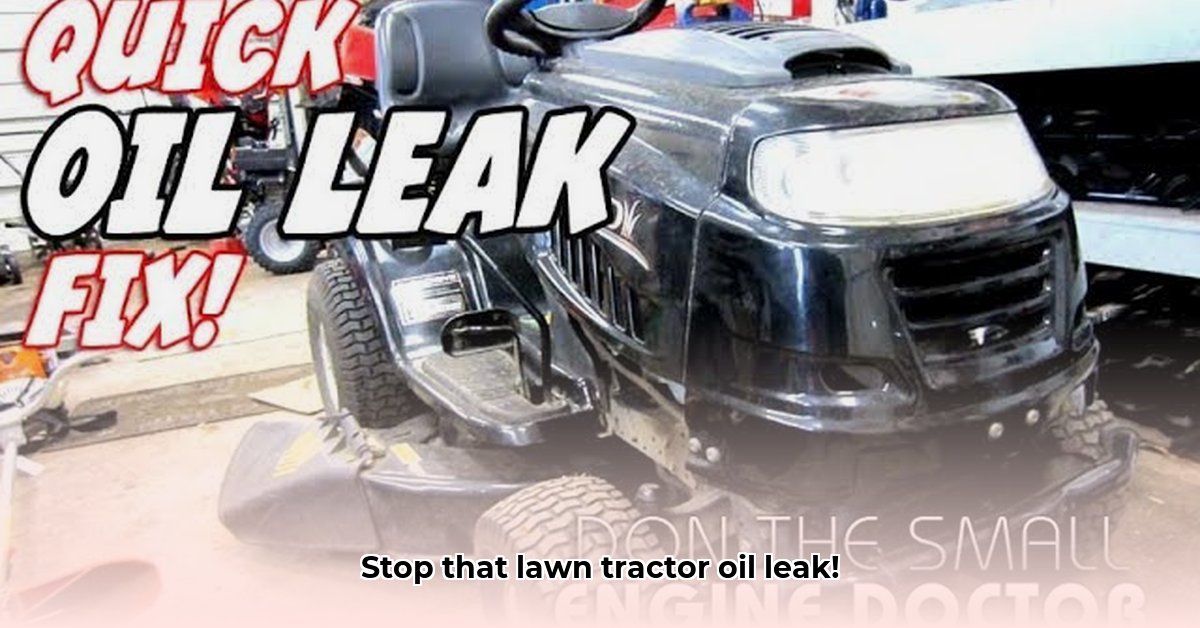
Uh oh! Oil is dripping from your lawn tractor. Don't panic! This is a common problem, and often easily solved with a little DIY know-how. This guide will walk you through troubleshooting and repair, getting your machine back to mowing perfection. Let's get started! For more advice, check out this helpful lawn tractor forum.
Safety First: Protecting Yourself and Your Equipment
Before you begin any repairs, prioritize safety. Turn off the tractor's engine and let it cool completely. Hot oil is dangerous! Wear work gloves to protect your hands. Work in a well-ventilated area to avoid engine fumes.
Tracking Down the Leak: A Step-by-Step Approach
Finding the source of the leak is the first step. This is akin to detective work, but with oil stains instead of clues.
Visual Inspection: Carefully examine the underside of your lawn tractor with a flashlight. Focus on these common trouble areas: the oil filter, the drain plug, and the oil pan gasket. Note the severity of the leak: a slow drip, a steady stream, or a major spill? This helps determine the repair needed.
Oil Level Check: Use the dipstick to check your oil level. Overfilling can cause pressure and leaks. Ensure the level is within the manufacturer's recommended range (consult your owner's manual).
Leak Classification: Is it a minor seep, a moderate drip, or a significant flow? A small leak may just need a tightening; a larger one might require part replacement.
Repair Solutions: From Easy Fixes to Advanced Repairs
We'll tackle repairs in order of difficulty.
1. Easy Fixes (For Minor Seepage):
Tighten the Oil Filter: Gently tighten the oil filter. Overtightening can damage it. (Use a wrench if needed, but avoid excessive force.)
Secure the Drain Plug: Ensure the drain plug is firmly tightened. Replace it if stripped or damaged.
Minor Leak Sealant (Use Cautiously!): For extremely minor leaks (a tiny seep), a high-quality oil leak sealant might provide temporary relief. This is not a permanent fix and is only suitable for very small leaks.
2. Intermediate Repairs (Slightly More Involved):
Replace the Oil Filter: If tightening doesn't stop the leak, replace the filter. This is a relatively simple process, but consult your owner's manual for specifics.
Replace the Drain Plug Gasket: A damaged gasket is a common cause of leaks. This is a relatively easy replacement.
Replace the Oil Pan Gasket: A leak from the oil pan usually means a worn or damaged gasket. This requires more mechanical skill; consult your manual or seek professional help if needed.
3. Advanced Repairs (Best Left to Professionals):
Replacing Seals: Replacing engine seals requires specialized tools and expertise. This repair is typically best left to a qualified mechanic.
Repairing/Replacing the Oil Pan: A damaged oil pan necessitates professional attention. This is a major repair.
Preventative Maintenance: Avoiding Future Headaches
Regular maintenance can significantly reduce the risk of oil leaks.
Regular Oil Changes: Change your oil per your owner's manual recommendations. Use the correct type and grade of oil.
Correct Oil Level: Maintain the proper oil level, avoiding both overfilling and underfilling.
Regular Inspections: Periodically inspect your tractor for any signs of leaks. Early detection simplifies repairs.
When to Call a Professional
For significant leaks, especially those involving major components or requiring extensive disassembly, consult a professional mechanic. Professional help prevents further damage to your valuable lawn tractor.
Additional Resources
Your owner's manual contains vital information on oil type, capacity, and maintenance. Online forums and YouTube tutorials (for your specific model) can also provide valuable assistance. Remember, safety first!
Key Takeaways:
- Regularly inspect and maintain the correct oil level.
- Simple fixes often resolve minor leaks.
- More complex repairs may require professional assistance.
- Preventative maintenance is key to long engine life.
- Know when to call a professional mechanic.